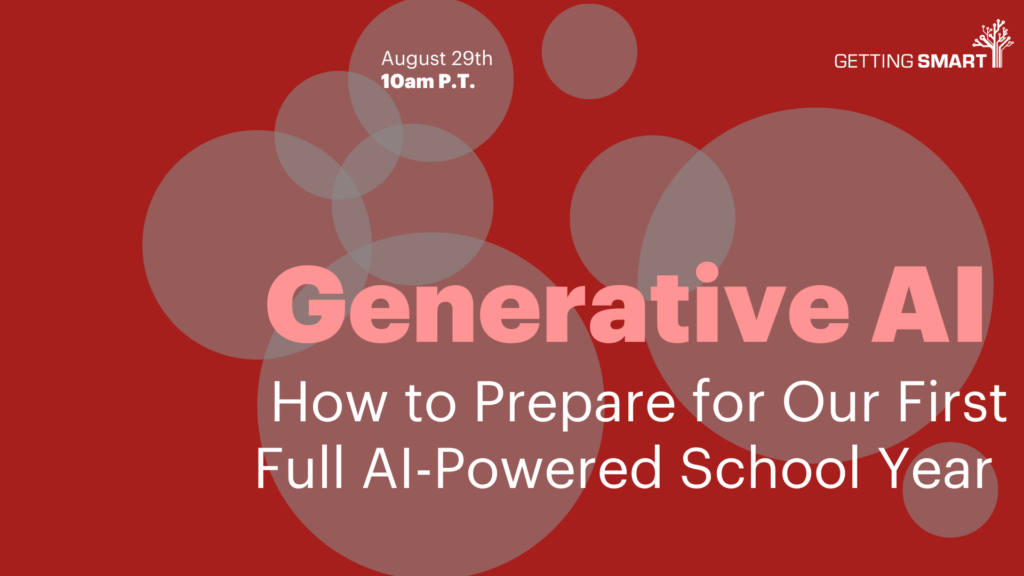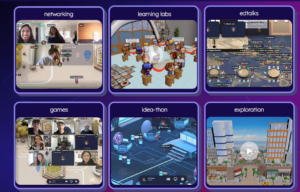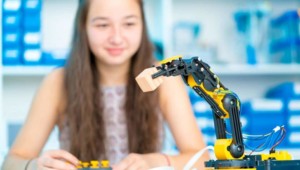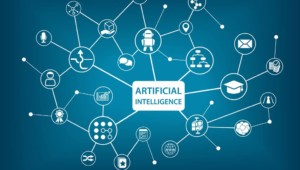Town Hall Recap: Generative AI

On the recent Getting Smart Town Hall, we were joined by leaders who are thinking about generative AI and its implications and uses in the classroom. Throughout the conversation, we focused on how to ensure that your school is a safe and constructive place that embraces AI, while doing the work to set the proper agreements and expectations up front. We highlighted a few individuals who are working with their teams to address and utilize generative AI, including Steven Eno from Da Vinci Public Schools, Keeanna Warren from Purdue Polytechnic and Jim Newland from Hickman Mills.
Steven Eno shared first, highlighting Da Vinci’s own Project Leo, a generative AI tool that uses inputs like ”design is communicating ideas through computer-aided design and sketches” and “use data to make decisions” as framing parameters for project generation. Students then put in a topic and the tool creates 5 personalized projects for every query.
After, we highlighted a few different districts and schools that had taken thoughtful steps to incorporate AI-enabling parameters in their rules and regulations. One example of this was Peninsula School District 401. Not all schools, however, are thinking proactively about this topic. Ted Mo Chen, ClassIn’s VP of Globalization, shared over email that some are advocating for a ‘post-plagiarism’ world. “[One example is] Michigan’s Hemlock Public School District which provided an aggregated list of AI classroom tools to its teachers. Others like Oklahoma’s Tomball ISD have added a brief sentence that, ‘student work submitted for academic credit and completed using AI will be considered plagiarism.’”
He added, “Still, other schools are taking a wait and see approach to drafting policy while putting in place measures to block students from using AI tools. LAUSD has blocked ChatGPT from all school computers while simultaneously rolling out an AI companion for parents. New York Public schools banned ChatGPT then undid that ban.”
As always, our audience shared numerous outstanding links and examples. We’ve decided to publish both the list of links and a lightly edited chat so that more people can see the engaging conversation.
Additionally, a few great examples of how educators are using AI were submitted over email:
PD for the AI age
St. Vrain has launched Exploration AI, a program that includes the following approaches to AI professional learning:
- Self-Directed, Gamified Learning: Throughout the year, educators in St. Vrain Valley Schools engage in an AI-centric Bingo game. This encourages them to experiment with a range of AI tools in scenarios like designing a weekend getaway, formulating a personal workout regimen, or crafting innovative formative assessment strategies aligned with student learning outcomes.
- EdCamp Pop-Ups: Diverging from conventional professional development paradigms, our educators can participate in monthly sessions that emphasize collaborative dialogue and shared learning, demonstrations, and hands-on experimentation designed to enhance their pedagogical tactics and their understanding of AI’s myriad applications.
- School Champions: Each school will identify an “Exploration AI” champion, who will collaborate with the school’s leadership team to interweave AI strategies into their site-based monthly late-start professional development days. These champions, likely AI pioneers themselves, will invigorate and inspire the broader school community with their passion and knowledge.
Lift the burden of tedious tasks
Kristina Holzweiss, 2015 School Library Journal School Librarian of the Year, New York
Any teacher will tell you that although we love the act of teaching, many hours of our day are spent doing other things. While I know that everything I do matters, I also used to spend a lot of time on tasks that felt like they took away from my opportunity to focus on the core task of teaching students. That’s where AI has been a game-changer for me. After 28 years teaching, I finally have a tool that can take some of the tedious tasks off my plate. I’ve started using AI to generate my first draft of a lesson plan or activity, giving me the time to use my years of experience to refine the content, differentiate it for the diverse needs of my students, and even tailor it to incorporate the interests and passions of the children in my class. When AI quickly gets the work started, it frees me up to use my expertise in ways that accelerate learning and make my classroom a more joyful, engaging place.
Support the social and emotional needs of students
Erika Sandstrom, Digital Learning Coach and Digital Media Teacher, Massachusetts
It’s all over the news – far too many of our children are in the midst of an unprecedented mental health crisis. From inside our classrooms, teachers are often on the frontlines of identifying mental health needs and helping students process, cope, and recover so that they can get back to the business of learning and growing. While so much goes into that heavy lift for teachers, I’ve had enormous success in using AI-powered tools to help me, help them. I created a custom, animated template called “My Breathing Bubble” to help my students with mindfulness and breathing exercises, and together we use Canva’s Text-to-Image AI feature to help each student personalize that tool to their unique needs. Over the years, I’ve watched as students dealing with anxiety, anger, hyperactivity, and aggression all use this tool to help themselves in school and at home. I’ve heard stories of my students bringing their breathing bubbles to siblings, friends, and even their parents. AI may seem like an unlikely tool for mental health, but I’ve seen the benefits firsthand.
Enable greater differentiation and more inclusive classrooms
Lisa Fichtorn-Scumpieru, Education Technology Coach, Maryland
Some people might look at a classroom and think there is one lesson being taught. The reality is that teachers are often teaching each student in a slightly different way, at a slightly different pace. That requires a lot of work but increasingly, teachers are finding ways to use AI to better reach every learner. Take for example, English Language Learners. Teachers can use AI to translate activities and presentations into any language, allowing students to progress at their own pace even as they learn English. Alternatively, I’ve worked with Special Education teachers who use AI to teach simple concepts with engaging graphics, videos, and activities. Using AI, teachers can request templates for multiple learning levels and set a fun, engaging topic as the vehicle for learning. More and more, educators are finding ways to use this powerful technology to level the playing field for all students and create classroom environments that make all learners feel supported and engaged.
Unlock creativity with new ideas
Joe and Kristin Merrill, Elementary School Teachers, Florida
The opportunities with and applications for AI are so much greater than are often explored in the media. It’s not just about entering a prompt and getting content in response. AI-powered platforms can help teachers more easily cultivate an environment that allows students to collaborate, get creative, think critically, and communicate visually. There are options that can help educators create images, videos, and more interactive activities. There are ways to leverage music, language translation, and animation. Our students live in a visual, interactive world. Through leveraging AI, we can make our classrooms a better, more engaging reflection of all that surrounds them.





0 Comments
Leave a Comment
Your email address will not be published. All fields are required.